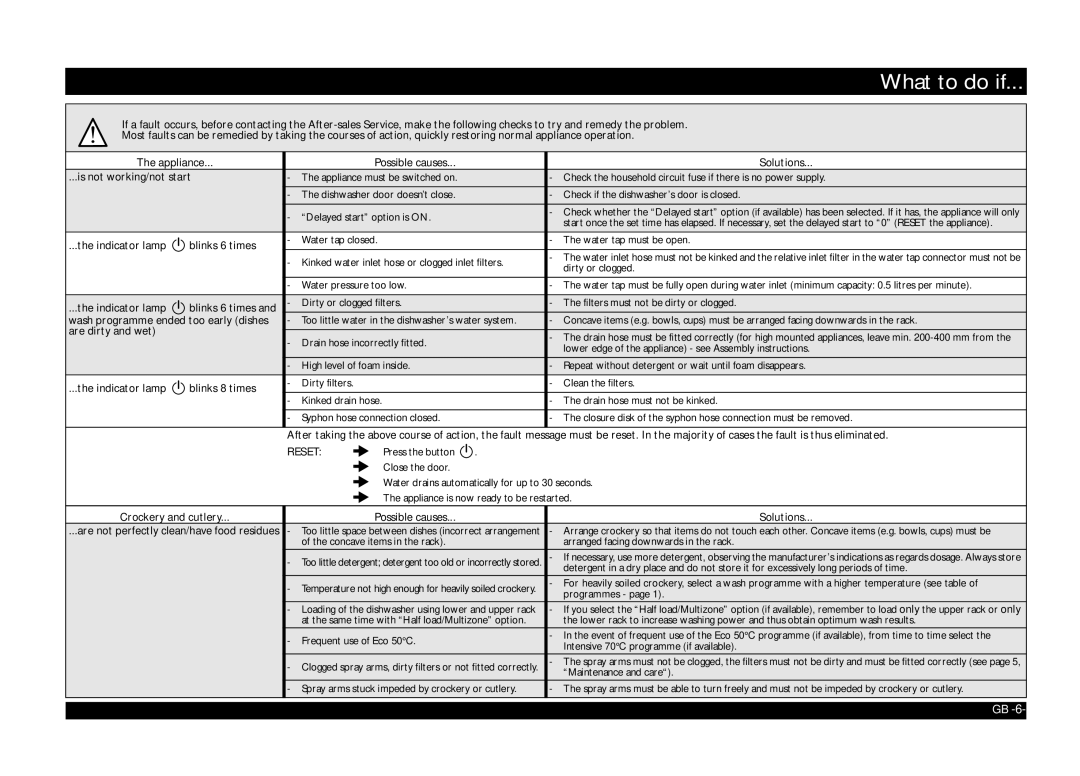
What to do if...
If a fault occurs, before contacting the
Most faults can be remedied by taking the courses of action, quickly restoring normal appliance operation.
The appliance... |
| Possible causes... | Solutions... | ||
...is not working/not start | - | The appliance must be switched on. | - Check the household circuit fuse if there is no power supply. | ||
|
|
| - The dishwasher door doesn’t close. | - Check if the dishwasher’s door is closed. | |
|
|
| - “Delayed start” option is ON. | - Check whether the “Delayed start” option (if available) has been selected. If it has, the appliance will only | |
|
|
| start once the set time has elapsed. If necessary, set the delayed start to “0” (RESET the appliance). | ||
|
|
|
|
| |
...the indicator lamp |
| blinks 6 times | - | Water tap closed. | - The water tap must be open. |
| |||||
|
|
|
| ||
|
|
| - Kinked water inlet hose or clogged inlet filters. | - The water inlet hose must not be kinked and the relative inlet filter in the water tap connector must not be | |
|
|
| dirty or clogged. | ||
|
|
|
|
| |
|
|
|
|
| |
|
|
| - Water pressure too low. | - The water tap must be fully open during water inlet (minimum capacity: 0.5 litres per minute). | |
|
|
|
|
|
|
...the indicator lamp |
| blinks 6 times and | - | Dirty or clogged filters. | - The filters must not be dirty or clogged. |
| |||||
wash programme ended too early (dishes | - | Too little water in the dishwasher’s water system. | - Concave items (e.g. bowls, cups) must be arranged facing downwards in the rack. | ||
are dirty and wet) |
|
| - Drain hose incorrectly fitted. | - The drain hose must be fitted correctly (for high mounted appliances, leave min. | |
|
|
| |||
|
|
| lower edge of the appliance) - see Assembly instructions. | ||
|
|
|
|
| |
|
|
| - High level of foam inside. | - Repeat without detergent or wait until foam disappears. | |
...the indicator lamp |
| blinks 8 times | - | Dirty filters. | - Clean the filters. |
| |||||
|
|
|
| ||
|
|
| - | Kinked drain hose. | - The drain hose must not be kinked. |
|
|
|
|
| |
|
|
| - Syphon hose connection closed. | - The closure disk of the syphon hose connection must be removed. | |
|
|
|
|
|
|
After taking the above course of action, the fault message must be reset. In the majority of cases the fault is thus eliminated.
RESET: |
| Press the button |
| . |
|
|
Close the door.
Water drains automatically for up to 30 seconds.
The appliance is now ready to be restarted.
Crockery and cutlery... | Possible causes... | Solutions... |
...are not perfectly clean/have food residues | - Too little space between dishes (incorrect arrangement | - Arrange crockery so that items do not touch each other. Concave items (e.g. bowls, cups) must be |
| of the concave items in the rack). | arranged facing downwards in the rack. |
| - Too little detergent; detergent too old or incorrectly stored. | - If necessary, use more detergent, observing the manufacturer’s indications as regards dosage. Always store |
|
| detergent in a dry place and do not store it for excessively long periods of time. |
| - Temperature not high enough for heavily soiled crockery. | - For heavily soiled crockery, select a wash programme with a higher temperature (see table of |
| programmes - page 1). | |
|
| |
| - Loading of the dishwasher using lower and upper rack | - If you select the “Half load/Multizone” option (if available), remember to load only the upper rack or only |
| at the same time with “Half load/Multizone” option. | the lower rack to increase washing power and thus obtain optimum wash results. |
| - Frequent use of Eco 50°C. | - In the event of frequent use of the Eco 50°C programme (if available), from time to time select the |
| Intensive 70°C programme (if available). | |
|
| |
| - Clogged spray arms, dirty filters or not fitted correctly. | - The spray arms must not be clogged, the filters must not be dirty and must be fitted correctly (see page 5, |
|
| “Maintenance and care“). |
| - Spray arms stuck impeded by crockery or cutlery. | - The spray arms must be able to turn freely and must not be impeded by crockery or cutlery. |
|
|
|
GB
